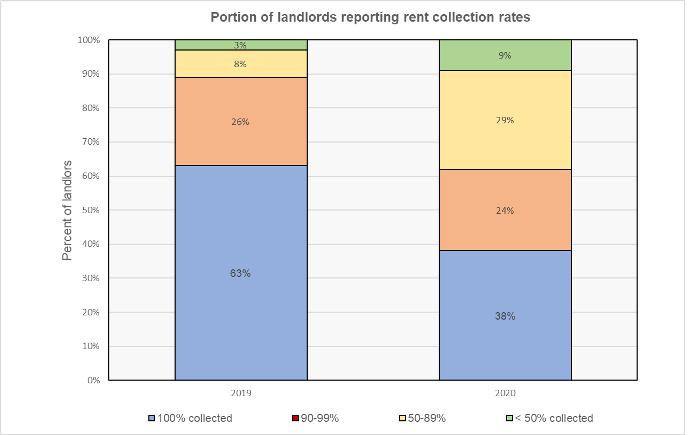Harvard’s Joint Center for Housing Studies (JCHS) recently issued a report assessing how landlords are faring during the COVID pandemic. The report studied how their rent collections and business practices changed between 2019 and 2020.
Setting the sample
The researchers sent out nearly 60,000 questionnaires to landlords in ten cities* and received just under 3,000 replies. The majority of the respondents were small landlords with 66 percent owning 1-5 rental units, 17.2 percent owning 6-19 rental units and 17.2 percent owning 20 or more rental units. Only 22 percent of respondents reported owning apartment buildings (5 or more units per building).
The majority of landlords managed their own properties with only 28 percent stating that they used a property management company. Most landlords who responded have market rate properties with only 21 percent saying that they have at least one renter using Section 8 vouchers.
The first chart, below, shows how rent collections changed between the pre-pandemic year of 2019 and the pandemic year of 2020. In 2019, 63 percent of landlords collected all of the rent that they were owed. This figure fell to only 38 percent in 2020. In 2019, only 3 percent of landlords collected less than 50 percent of the rent that they were owed. This figure rose to 9 percent in 2020.

The next chart shows differences in how landlords worked with their renters. Actions such as granting rent extensions, forgiving rent and decreasing the rent were relatively rare before the pandemic. After the pandemic, the portion of landlords offering these concessions to renters increased by 3 times or more. Conversely, actions such as charging rent fees or increasing rents were used by around a quarter of landlords before the pandemic. After the pandemic, the portion of landlords taking these actions dropped to half or less of the pre-pandemic levels. Interestingly, the portion of landlords initiating eviction actions remained at nearly the same level during the pandemic as in the pre-pandemic period despite the widespread imposition of eviction moratoriums.

Adjusting business practices
The last chart shows how landlords adjusted their operating practices in response to their reduced rent collections. The portion of landlords who missed payments on their own mortgages or taxes jumped from 4 percent to 19 percent. The portion of landlords who deferred needed maintenance on their properties jumped from 5 percent to 31 percent. Finally, the portion of landlords who listed their properties for sale jumped from 3 percent to 13 percent.

Having landlords defer maintenance on their properties and seek to exit the business does not bode well for the availability of quality, affordable rental housing.
The full JCHS report is 50 pages long and contains detailed explanations for how the data was collected. It also breaks out some of the results by city and by demographic factors. The full report can be found here.
*Akron, Ohio; Albany and Rochester, New York; Indianapolis, Indiana; Los Angeles, California; Minneapolis, Minnesota; Philadelphia, Pennsylvania; Racine, Wisconsin; San Jose, California; and Trenton, New Jersey.













